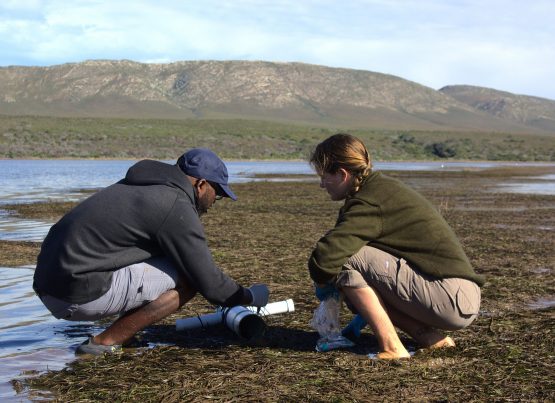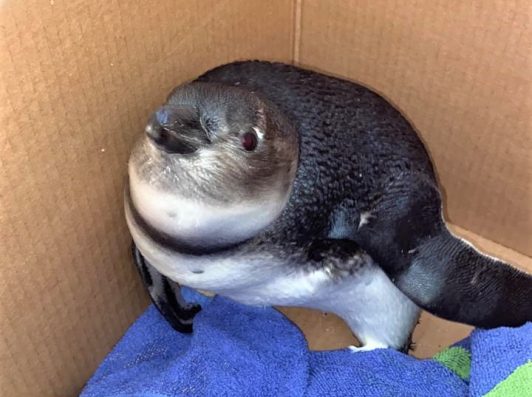RiverWise
Issue 33 ~ June 2021
The monthly newsletter of the Lower Breede River Conservancy Trust
How your membership
can help the Breede
All estuaries in South Africa are under severe pressure resulting from over-exploitation of natural resources, habitat destruction and deterioration of water quality.
If you take an active interest in, or use, the Breede River Estuary we hope that we can persuade you to become a member of the LBRCT and to support our endeavours on your behalf by way of your contribution to these efforts.
The authorities who are ultimately responsible for ensuring protection of our valuable natural resources are contributing, however, they simply cannot afford to allocate sufficient of their available funds to meet the estuary’s conservation needs.
Your membership contribution supplements the funds obtained from the licence fees paid by users of boats; the municipalities by way of supplementary grants constrained by their many other social upliftment and development imperatives, and grants from those government agencies to whom we are contracted.
There are 62 estuaries in the Western Cape and all need support. The Breede is one of the two largest and most important and we all need to play a role in preserving it. 100% of your membership subscriptions are put to the best possible use to help maintain the conservation infrastructure that has taken many years to put in place and initiate new projects such as:
• Turtle and penguin rescue transport
• Environmental education programmes
• Holiday activity programmes
• Funding conservation interns
• Printing brochures, pamphlets, posters and information packs
• Producing and erecting signage
• Materials and equipment for monitoring projects
For R 100 a year, you can assist us with all of the above and add your voice that is so important to ensure that your opinions and concerns are heard. The LBRCT can speak more authoritatively when dealing with the vast number of threats, regulations and legislation that already affect the estuary with the backing of a sizeable member base.
Please think about the future of the estuary and the importance of maintaining its good health for you and your children’s benefit through supporting our effort.
Yes I want to support the Breede...
Have you renewed your boat licence yet?
Annual Municipal Boat licenses are due for renewal every year from 1 July and valid until 30 June the following year.Just a reminder of our outlets available for boat license sales for 2021/2022
MALGAS OUTLET:
Living the Breede
Phone: 067 162 9081 or 082 324 2757
Open: Mon-Sun from 08:00 - 17:00
RIVERINE OUTLET:
Breede Riverine Estate
Phone: 028 542 1345
Open: 09:00 – 17:00
WITSAND OUTLETS:
Lower Breede River Conservancy Office
Phone: 028 537 1296
Open: Mon-Fri 08:00 - 16:00
Sands Supermarket
Phone: 028 537 1800
Open: 09:30 - 16:30
SWELLENDAM OUTLETS:
Heyneman Yamaha
Phone: 028 514 2010
Open: 08:00 – 17:00
Infanta Inflatables
Phone: 028 514 1589
Hours:08:00 - 17:00 Monday to Thursday
08:00 - 16:00 Friday, Closed Weekends
ONLINE LICENSES:
Buy your boat license online and arrange to pick up your disk at Living the Breede (Malgas) or LBRCT office (Witsand)
https://breede-river.org/licences/
Contact our office if you have any questions regarding the boat licenses - 028 537 1296 / info@breede-river.com
In this issue
June has provided many beautifully calm days for us to carry out our work. We have assisted Stellenbosch University with seagrass sampling, rescued an injured penguin, and conducted our monthly bird count and water quality runs. Also included is reminders about the persistent water hyacinth, updates on the nasty bird flu outbreak (HPAI), and information on the implementation of the POPIA. In addition there is an article on the Bar-tailed Godwit.
Follow us on your favourite social media platform to see what we are up to daily!
Seagrass sampling
The LBRCT assisted Dr Andrew Ndhlovu from the University of Stellenbosch with seagrass sampling on 25 and 26 June. We took him up river to view the state of the seagrass beds and take soil, root and whole specimen samples at Groenpunt and Skuitbaai.
A large pole was knocked into the mud to obtain a core soil sample.

Vegetation and macrofauna samples were also taken using a PVC apparatus.


The core was separated according to depth and bagged for further analysis at Stellenbosch University.



Seagrasses form extensive underwater meadows of highly productive and biologically diverse habitats. They provide invaluable ecosystem services in terms of nursery habitats, foraging grounds, nutrient cycling, and pollutant control. This directly protects humans, but also indirectly provides cultural benefits as these grasses support recreational opportunities.
The reason seagrass is receiving more attention nowadays by scientists and policy-makers is due to their mitigation and adaptation capabilities which are used to combat climate change. Seagrass meadows are highly efficient carbon sinks and their ability to buffer ocean acidification owes to the resilience of vulnerable ecosystems.
Threats with the highest impact to seagrasses include agricultural and industrial run-off, coastal development and climate change. Unregulated fishing activities, anchoring, trampling and dredging also pose major threats. Studies have shown that protecting meadows generally slows their rate of decline and in many cases promotes substantial recovery of the seagrasses. Let's please protect these sensitive and importance components of our ecosystem!
Bar-tailed Godwit
The Bar-tailed Godwit is one of three Godwit species that visit southern Africa during spring and summer. The Bar-tailed Godwit is the only regular visitor to our shores and is uncommon to locally common between October and April.
This non-breeding migrant is found in small flocks. Along the Breede Estuary this species is uncommon and usually only seen in small numbers (less than 10 individuals).
Male and female Bar-tailed Godwits look similar in non-breeding plumage with females larger than males. Breeding plumage can be seen in late March and April before the birds head back to their breeding grounds in northern Europe, Asia and Alaska. They only attain full breeding plumage until they are at least 2 years old.
They occur mostly in estuaries and lagoons with sandy or muddy substrates using its long bill to find polychaete worms (bristle worms), molluscs, crustaceans and fish fry. Globally it is listed as Near-Threatened.
Bibliography
Chittenden H, Davies G, Weiersbye I. 2016. Roberts Bird Guide: Second Edition.
Ginn P, McIlleron G. 2014. The ultimate Companion for Birding in southern Africa.
Penguin rescue
This juvenile African penguin was rescued in Witsand on 16 June. It had some injuries and was transported to the African Penguin and Seabird Sanctuary (APPS) in Gansbaai.

In the data
Monthly routine monitoring
June bird counts
Our monthly bird count was conducted on 11 June. As soon as the mist disappeared we set off to start the count at the river mouth. A total of 319 birds were recorded, with the most common being the African sacred ibis (54), Yellow-billed duck (32), and Kelp gull (31). A rare observation was of a Terek sandpiper (See picture under Photo-of-the-month). These birds are migratory and only occasionally overwinter here in South Africa. Another interesting bird of prey was sighted - the Black harrier.
June water quality
The salinity of the river flatlined after Bobbejaanskrans (20 km upriver). Water is deemed to be fresh if it is below 0.5 PSU. As we can see from the graph, Mudlark has the highest salinity of 31.85 PSU and after Bobbejaanskrans the conditions stayed consistently just above fresh. The temperature was cooler than last month, ranging 14.5 - 16 degrees. Interestingly, the temperature recorded at Mudlark was significantly higher than at other sites and this corresponds to the higher salinity reading.
For comparison and interest sake we have included last month's water quality results as well. Fresh water was reached not far upriver in May due to heavy rains.
Water hyacinth reminder
This is just a friendly reminder that the winter rains will bring more and more fresh water downriver. This will facilitate the establishment of the alien water hyacinth. Their invasiveness stems from their ability to clone, resulting in large patches of sharing the same genetic makeup. Removing these pests permanently has been problematic as more and more float down from upriver. We would like to ask that each home owner takes responsibility for the water hyacinth that accumulates in front of their property and removes it. Water hyacinth cannot survive out of water and also makes good compost as they are full of nutrients which they've taken out the water for self-growth.

Photos of the month
The photo-of-the-month competition is an initiative which the LBRCT is promoting whereby members of the public can send us their photographs of anything related to the natural beauty of the Breede River! Please send your photos to conservation@breede-river.org.

Terek sandpiper (Xenus cinereus)

Giant kingfisher (Megaceryle maxima)
Attention!
There has been an outbreak of bird flu that is severely infecting both terrestrial and aquatic birds. The H5N1 strain of highly pathogenicity avian influenza (HPAI) is a bird flu that results in neurological issues and ultimately death. This disease has increased in severity since April 2021.
Please be on the lookout for infected birds and increased numbers of dead birds and report any bird suspected to be affected by the disease to your local state veterinarian and/or the Lower Breede River Conservancy Trust. Symptoms of this highly contagious disease include tremors, seizures, loss of balance, swimming in circles or head twitches and other abnormal head and neck movements.
Gulls, pelicans and penguins may be more likely to present symptoms. Recording a video of the bird will be helpful in further understanding the disease. For more information please contact SANCCOB (Office hours +27 21 557 6155, After Hours +27 78 638 3731)
For a map of the recorded cases in the Western Cape click here.
For a map of the state vets in the Western Cape click here.
Protection of Personal Information Act (POPIA)
We hope you're staying safe and healthy.
The Protection of Personal Information Act (aka POPIA) came into effect on 1 July 2021. The act requires that we obtain your consent to communicate with you in the future.
This could be in the form of our social media posts, environmental updates, newsletters, and more. If you are happy to keep receiving communication and updates from us there's no need to do anything.
If you change your mind at any time in the future, an unsubscribe link can be found at the foot of all our emails.
Thank you for reading
We hope you enjoyed this months' issue. Should you have any feedback, questions, or matters you would like us to cover in a future issue, please do not hesitate to write to us at news@breede-river.org.